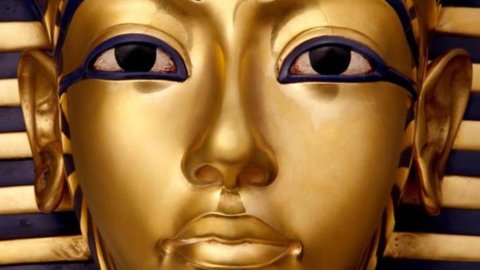An idea so simply beautiful that it is surprising that no one has thought of it until now. This is the feeling that was felt in Vicenza, at Palazzo Trissino, when the Mayor Achille Variati and the Deputy Mayor Jacopo Bulgarini d'Elci announced the great exhibition – the critic and curator's third in Vicenza – that Marco Goldin was called to propose in the Basilica Palladiana, starting from Christmas Eve 2014.
The big news is the entry of the Fondazione Teatro Comunale della Città di Vicenza as Promoter, in collaboration with the Municipality of Vicenza and Linea d'ombra, with the contribution of the Fondazione Cassa di Risparmio di Verona, Vicenza, Belluno and Ancona. Main Sponsor the Segafredo Zanetti Group.
The title: "Tutankhamun Caravaggio Van Gogh. The evening and nocturnes from the Egyptians to the twentieth century” is, without a doubt, one of those that make your head spin. It recalls millennia of human and art history, pinned in an exhibition that investigates an ancient history but above all a second history, from the sixteenth to the twentieth century in painting, along its poignant evening and nocturnal side. But without connoting, in fact, this side of his with any fear, anguish, negativity, to read it instead in the key of love. Hence the presence of wonderful sunsets and works in which the night gives way to the first glimmer of dawn. To give the night its most complete image of temporal continuity.
As true artists know how to do when, in depicting a moonlight, they instill feelings and deep soul correspondences in the visual, “photographic” element. Like someone who “simply” sees the other face of light in the dark or just the beautiful space that separates us from dawn. The night, these nights, are a very personal journey from sun to sun, passing through the annulment of light which never coincides with any eclipse of life.
Eighty works, as always magnificent, rare, international, set this fascinating symphonic tale to music.
A poem that begins along the Nile, where the idea of the night of the world beyond the world settles. It is the night inhabited in the belly of the Pyramids. Told in the exhibition by finds which alone are worth the trip to Vicenza. From the Museum of Fine Arts in Boston, a nucleus of astonishing Egyptian treasures arrives in Italy for the first time: from the trousseau of Queen Hetherphes, to the famous face of the child king Tutankhamen up to the Portraits of the Fayum, when Egypt and Rome approach each other, starting from end of the XNUMXst century AD c.
This is the great prologue. Which is followed by an even grander poem made up of masterpiece paintings that tell the story of full night or sunset or twilight, the storm of stars, the arrival of dawn. We start from the sixteenth and seventeenth centuries, from the great Venetians, Lombards and Emilians: Titian, Lotto, Bassano, Tintoretto, Savoldo, Caravaggio, Correggio, Carracci, to look at the Flemings such as Rubens or Elsheimer or De La Tour in France, El Greco and Zurbaran in Spain, Dutch like Rembrandt and Van Honthorst, up to the painters of the eighteenth century, from Magnasco to Füssli, to the pre-Romantic ones like Wright of Derby, Canaletto, Guardi. Then American painting, with a particular eye to the wonders of Church and gradually up to Hopper. In the French context Millet, Corot, Courbet and, among the impressionists Whistler first and then Manet, Cézanne, Pissarro, Monet, Gauguin and finally Van Gogh. A special tribute will be reserved for him: 10 "museum" works, so much so that to grant them are the Van Gogh Museum in Amsterdam and the Kröller-Müller Museum in Otterlo, i.e. the two temples of Vincent's art. His famous "Night Trail in Provence" was, not surprisingly, chosen as the logo of the exhibition.
But the path conceived by Goldin also includes Van Gogh and the 2009th century and, passing through the emotion of Böcklin, leads the exhibition towards the new century to meet Matisse first and then Bonnard, experiencing many forays into the work of some sensational painters of the mid-twentieth century, for example from De Staël to Rothko to Bacon, up to the closure with the Spanish Lopez Garcia and with an extraordinary American painter, who passed away in XNUMX, which is Andrew Wyeth.
“Testifying – Goldin concludes – the sense of a night which is no longer just the result of physical and reproductive seeing, but internal and determined by the psychological depth of dreams and memory. In an exhibition which, as the title says, aims to unite in an otherwise impossible encounter, the feeling that arises from the pride of Tutankhamen's nocturnal journey and Vincent van Gogh's tormented journey under the moon and the stars. When the night is the representation of life, its limit and at the same time its culmination which is surpassed in the space of time".
TUTANKHAMON CARAVAGGIO VAN GOGH. In the evening and at night from the Egyptians to the twentieth century
Vicenza, Palladian Basilica
From December 24, 2014 to June 2, 2015





